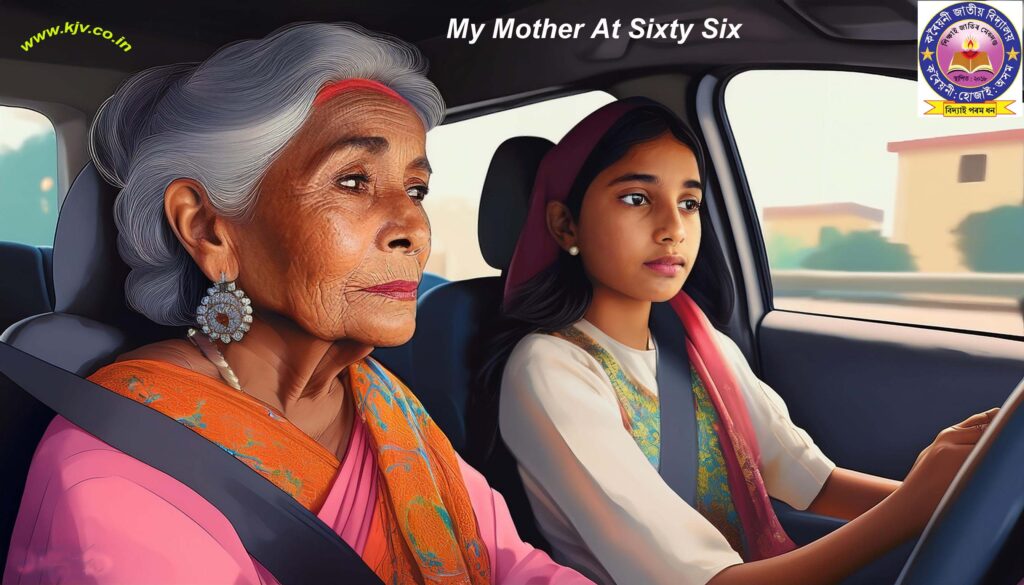My mother at sixty six question answers, class 12 English by kjv expert Teachers
My Mother at Sixty Six Question Answers
Class 12 Poetry
Question & Answers
Q.1. What is the kind of pain and ache that the poet feels.
Ans: The poet feels an old, familiar pain from childhood—a fear of aging, decay, and death. As people grow older, separation and death become inevitable, including for the poet’s mother.
Q.2. Why are young trees described as ‘ sprinting ‘ ? Or, What do the young sprinting signify in the poem ?
Ans: Young trees are described as ‘sprinting’ because, when traveling fast, stationary objects seem to blur and move quickly. This contrasts with the old lady sitting passively inside the car.
Q.3. Why has the poet brought in the image of the merry children ‘spilling out of their homes’ ?
Ans: The poet uses the image of merry children ‘spilling out of their homes’ to highlight the contrast between her mother’s lifelessness and the vibrant, joyful world outside. The lively children make the poet’s mother’s sadness and passivity even more striking.
Q.4. Why has the mother been compared to the late winter’s moon ?
Ans: The mother is compared to the late winter’s moon because her face is pale and lacks brightness, similar to how the moon appears in late winter.
Q.5. What do the parting words of the poet and her smile signify ?
Ans: The poet’s parting words and smile show her acceptance of the inevitable separation and death of her mother. She hides her fear of losing her mother with a smile, signaling her understanding and acceptance of this reality.
Q.6. Describe the poetic devices used by the poet Kamala Das in ‘My mother At sixty-six ‘?
Ans: In “My Mother at Sixty-Six,” Kamala Das uses vivid imagery. She describes the mother’s face as pale and lifeless, like a corpse or the late winter’s moon. The poet’s smile contrasts with her mother’s wan appearance, highlighting the difference between life and aging.
Question & Answers
Q.1. What is the kind of pain and ache that the poet feels.
Ans: The poet feels an old, familiar pain from childhood—a fear of aging, decay, and death. As people grow older, separation and death become inevitable, including for the poet’s mother.
Q.2. Why are young trees described as ‘ sprinting ‘ ? Or, What do the young sprinting signify in the poem ?
Ans: Young trees are described as ‘sprinting’ because, when traveling fast, stationary objects seem to blur and move quickly. This contrasts with the old lady sitting passively inside the car.
Q.3. Why has the poet brought in the image of the merry children ‘spilling out of their homes’ ?
Ans: The poet uses the image of merry children ‘spilling out of their homes’ to highlight the contrast between her mother’s lifelessness and the vibrant, joyful world outside. The lively children make the poet’s mother’s sadness and passivity even more striking.
Q.4. Why has the mother been compared to the late winter’s moon ?
Ans: The mother is compared to the late winter’s moon because her face is pale and lacks brightness, similar to how the moon appears in late winter.
Q.5. What do the parting words of the poet and her smile signify ?
Ans: The poet’s parting words and smile show her acceptance of the inevitable separation and death of her mother. She hides her fear of losing her mother with a smile, signaling her understanding and acceptance of this reality.
Q.6. Describe the poetic devices used by the poet Kamala Das in ‘My mother At sixty-six ‘?
Ans: In “My Mother at Sixty-Six,” Kamala Das uses vivid imagery. She describes the mother’s face as pale and lifeless, like a corpse or the late winter’s moon. The poet’s smile contrasts with her mother’s wan appearance, highlighting the difference between life and aging.
Q7: Why is the poet’s mother compared to the late winter’s moon?
Ans: The poet’s mother is compared to the late winter’s moon because both look pale and faded. Just as the late winter moon lacks shine and strength, the mother’s ashen face shows aging and loss of vitality.
SHORT ANSWER TYPE QUESTIONS (Word Limit: 30-40 words)
Q1. Where was the poet going and who was with her?
Ans: The poet was driving to Cochin airport from her parents’ home, with her mother sitting beside her. Her mother was dozing off with her mouth open, showing a contrast between the active journey and her mother’s passive state.
Q2. What was the poet’s childhood fear?
Ans: The poet’s childhood fear was being separated from her mother, or losing her.
Q3. What does the poet’s mother look like? What kind of images has the poet used to signify her ageing decay?
Ans: The poet’s mother, at sixty-six, is dozing with her mouth open, showing signs of old age. Her face is pale and ashen, resembling a corpse, symbolizing aging and decay.
Q4. What does the poet realise with pain? Why does the poet ‘put that thought away’ and look outside?
Ans: The poet feels pained by her mother’s lifeless, faded face, which reminds her of death and decay. To distract herself from this sad thought, she looks outside to see a lively, happy world.
Q5. Describe the world inside the car and compare it to the activities taking place outside?
Ans: Inside the car, the poet sees her mother’s pale, lifeless face, symbolizing decay and death. Outside, young trees appear to sprint by, and happy children are cheerfully leaving their homes, showing life and activity.
Q6. Why does the poet look outside? What does she see happening outside?
Ans: The poet looks outside because she finds it too hard to focus on her mother’s aging and lifeless face. She seeks a distraction and sees young trees speeding by and happy children cheerfully leaving their homes.
Q7. What does the poet do after the security check-up? What does she notice?
Ans: After the security check at the airport, the poet stands a few yards away and looks at her mother once more. She notices that her mother’s face is pale and colorless, like the late winter’s moon, reflecting aging and decay.
Extra Short Answers
Q. Who is the poet of the poem ” My Mother at Sixty-six ” ?
Answer – Mrs Kamala Das
Q. When was the poetess born ?
Answer – In 1934
Q. Name the place where the poetess was born ?
Answer – Malabar, Kerala
Q. Who is ” I ” in the poem ?
Answer – The daughter
Q. Which day is mentioned in the poem ?
Answer – Friday
Q. What is the pen-name of Kamala Das ?
Answer – Madhavikutty
Q. – Who has written the novel ” Alphabet of Lust ” ?
Answer – Kamaladas in 1977
Q. Name her some other works published :-
Answer – Padmavati the Harlot and Other Stories published in 1992.
Q. What is Padmavati the Harlot and Other Stories ?
Answer – Collection of Short Stories



